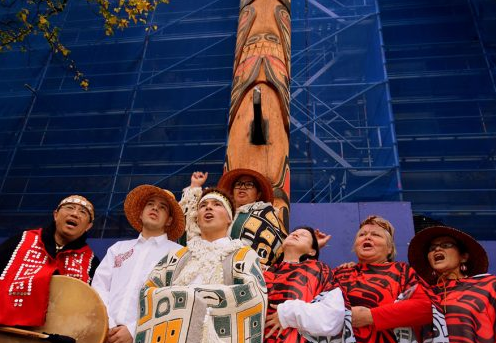 This small triangular park, on the north corner of Hastings and Carrall Streets is virtually on the east/west divide of Vancouver. It’s at the heart of Vancouver’s history, standing on the southeast corner of the 1870 Granville Townsite, which pre-dated the city of Vancouver. It’s also on the traditional territories of the Squamish, Tsleil-Waututh, and Musqueam First Nations.
This small triangular park, on the north corner of Hastings and Carrall Streets is virtually on the east/west divide of Vancouver. It’s at the heart of Vancouver’s history, standing on the southeast corner of the 1870 Granville Townsite, which pre-dated the city of Vancouver. It’s also on the traditional territories of the Squamish, Tsleil-Waututh, and Musqueam First Nations.
In the early 1900s, the area was literally the centre of the new city of Vancouver with City Hall, the courthouse and the BC Electric Railway head office all neighbours. There were banks and a vibrant shopping district on Hastings St. roughly between Main and Granville. Before the park was established, there was a CPR spur line on the site that connected the False Creek Railyards with the main line on Burrard Inlet. However, with the growth of the city the spur line became a traffic impediment and was eventually replaced with the Dunsmuir Tunnel in the early 1930s. Once the tracks were removed, plans were made for the conversion to a park. It was the depression years and many itinerant workers were milling around hoping to find work. It was felt that a little green space would brighten the area and give these labourers a place to rest. In 1938, the CPR deeded the land to the city.
Officially, the name of the park is Pioneer Place. Locals, however, began calling it Pigeon Park. People hanging out in the park fed pigeons and there were complaints before the park was paved over in the early 1960s that pigeons were ruining the grass.
After the depression, many itinerant workers left the area except for men who were disabled, sick or elderly. Pigeon Park became a place for these men to hang out and drink. At the same time, there was a shift to the west of the downtown district businesses, towards Granville St. and Robson St. Even City Hall relocated in 1936. Then there was the closure of the BC Electric Railway’s downtown office and depot in the 50s. All this resulted in a decrease of tourist traffic and gradually many local hotel rooms turned into run-down, low-rent housing. Prostitution became established in the 60s and the 80s introduced heavy drugs. At the same time, the provincial government had downsized mental heath facilities relocating many patients to the Downtown Eastside (DTES) without proper aftercare. The cut off of funding for social housing by the Federal Government in the 90s surely contributed to the prevalence of homelessness we see today. Cuts to the provincial welfare program in the early 2000s just put another nail in the coffin.
So today the DTES is one of the poorest areas in all of Canada. Drugs, mental illness, crime, prostitution, abject poverty, rising housing prices all make for a toxic mix and there is a high rate of Aboriginals living in the area who are immersed in this toxicity. All of this is reflected in the current frequenters of Pigeon Park. People are still hanging out, drinking, as well as doing drugs.
The situation may seem hopeless but what is amazing is the resilience of the residents! There are now three markets, one of them on Sundays at Pigeon Park, which allow local residents a modicum of pride in being able to sell goods to help supplement a meagre income.
There is the Local Economic Development Lab (LED Lab) which develops jobs for local residents. Projects include Hives for Humanity which produces honey, candles and related self-care products. ReBuild provides jobs in construction for DTES workers. Knack helps develop employment related skills. Binners’ Project is aimed at better organizing the environmentally positive recycling that binners do.
DTES residents have resisted their dispersion, fought for turning Carnegie Library into a community centre, and created the Insite centre as a safe injection site.
The prominent DTES arts community as well as SFU’s Woodward’s downtown campus stage events and festivals featuring local art and culture. This has certainly led to a positive mix in the area, with many students and artists. But simultaneously new trendy shops and restaurants are developing and certainly the seeds of gentrification have been sown.
What the future holds is anyone’s guess – a huge amount of resources have been thrown into the DTES, and many feel the results are dubious. The need to decently house people accompanied by comprehensive medical and social services has been shown to be the most cost effective solution. But this will not happen quickly with today’s priority on the lucrative housing market exacerbating the problem.
The picture shown here is from the Nov. 5, 2016 ceremony raising the Survivors Totem Pole in Pigeon Park. It is a symbol of healing that celebrates the survivors of the DTES and all those who have survived the effects of colonialism, racism, and poverty. An initiative of the DTES Sacred Circle Society, and the Vancouver Moving Theatre, it represents a three-year collaboration between First Nations, DTES advocates, the LGBTQ community, Japanese, Chinese and South Asians.
The 8 metre, 980 year old cedar tree was carved by Haida artist Skundaal and a team of 12 apprentices. She was the first woman apprentice of famed Haida carver Bill Reid and is a long time DTES resident. To Skundaal, the totem represents the fact that survivors are still standing and standing together. The animals carved on the pole symbolize transformation, protection, renewed strength and unity.

































